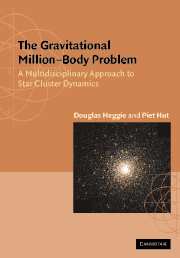Book contents
- Frontmatter
- Contents
- Preface
- PART I INTRODUCTIONS
- PART II THE CONTINUUM LIMIT: N → ∞
- PART III MEAN FIELD DYNAMICS: N = 106
- PART IV MICROPHYSICS: N = 2
- PART V GRAVOTHERMODYNAMICS: N = 106
- PART VI GRAVITATIONAL SCATTERING: N = 3
- PART VII PRIMORDIAL BINARIES: N = 4
- PART VIII POST-COLLAPSE EVOLUTION: N = 106
- PART IX STAR CLUSTER ECOLOGY
- Appendix A A Simple N-Body Integrator
- Appendix B Hints to Solution of Problems
- References
- Index
PART IX - STAR CLUSTER ECOLOGY
Published online by Cambridge University Press: 05 June 2012
- Frontmatter
- Contents
- Preface
- PART I INTRODUCTIONS
- PART II THE CONTINUUM LIMIT: N → ∞
- PART III MEAN FIELD DYNAMICS: N = 106
- PART IV MICROPHYSICS: N = 2
- PART V GRAVOTHERMODYNAMICS: N = 106
- PART VI GRAVITATIONAL SCATTERING: N = 3
- PART VII PRIMORDIAL BINARIES: N = 4
- PART VIII POST-COLLAPSE EVOLUTION: N = 106
- PART IX STAR CLUSTER ECOLOGY
- Appendix A A Simple N-Body Integrator
- Appendix B Hints to Solution of Problems
- References
- Index
Summary
The remaining chapters of the book go beyond the N-body problem as it is understood outside astrophysics. Here the fact that the bodies are stars is essential.
Chapter 30 sets the scene by summarising the various dynamical processes that have been introduced so far, the various kinds of stars and other relevant topics which are of interest in astrophysics (such as colour–magnitude diagrams) and, most importantly, the relations between these two sides of the problem. Special attention is paid to those kinds of stars which are readily observed and where dynamical processes are most immediately relevant: blue stragglers, millisecond pulsars and X-ray sources.
Chapter 31 analyses in some detail the simplest process where the stellar nature of the bodies is vital: collisions and other encounters between two individual stars, where the gravitational interaction is not the whole story. We estimate the rate of collisions, and how it depends on the stellar density and the kinds of stars present. Non-gravitational interactions are also vital in understanding the role and evolution of binary stars, especially when interactions with other (single) stars occur frequently enough. The effects of collisions on the participating stars are outlined, and we consider the dynamics of near-collisions, where non-gravitational effects are important (‘tidal capture’).
The dynamics and evolution of binary stars are taken up in detail in Chapter 32. Special attention is paid to the ways in which blue stragglers can arise from interactions involving binaries.
- Type
- Chapter
- Information
- The Gravitational Million–Body ProblemA Multidisciplinary Approach to Star Cluster Dynamics, pp. 277 - 278Publisher: Cambridge University PressPrint publication year: 2003



